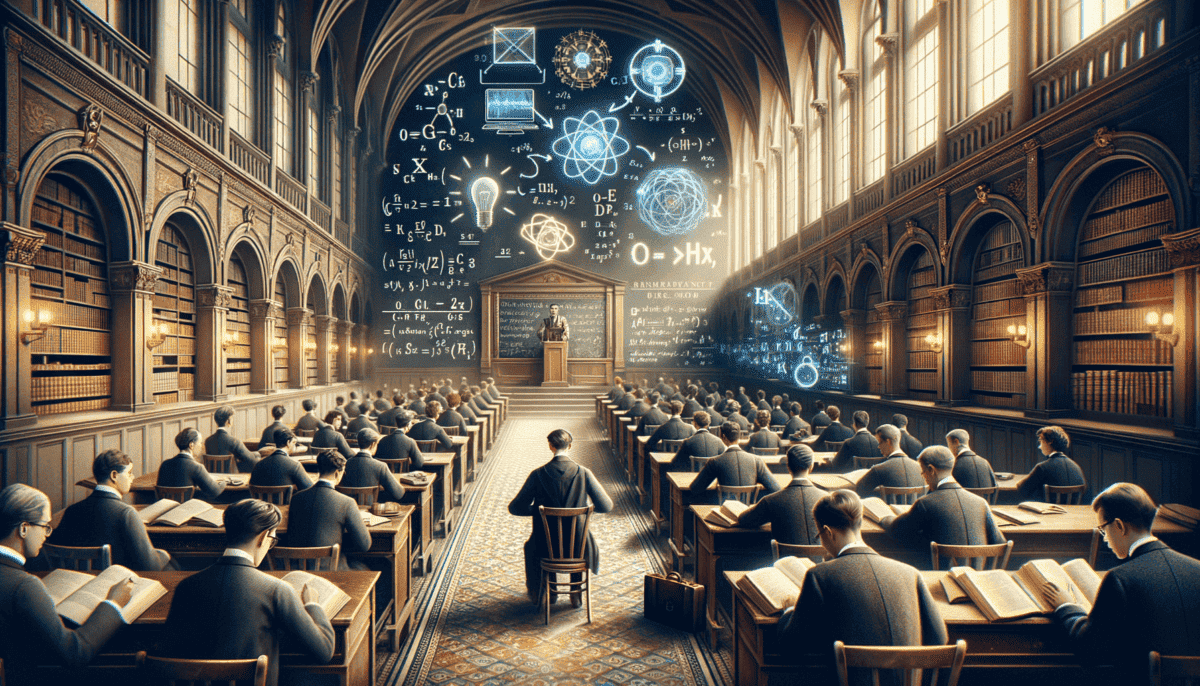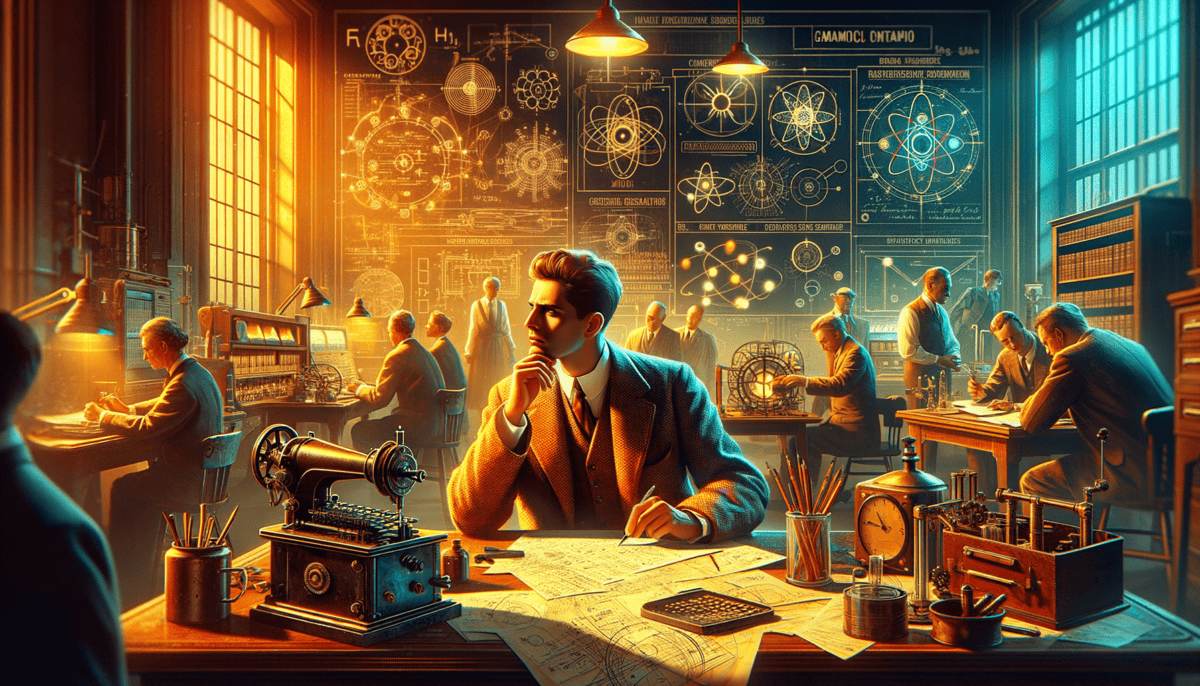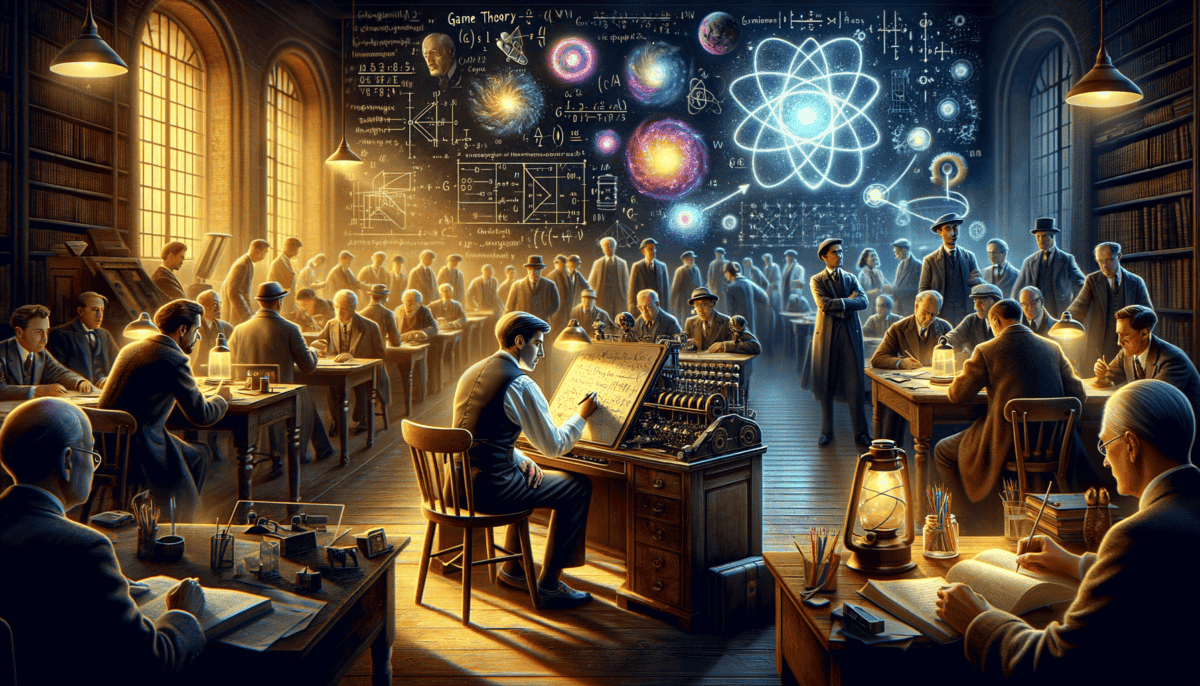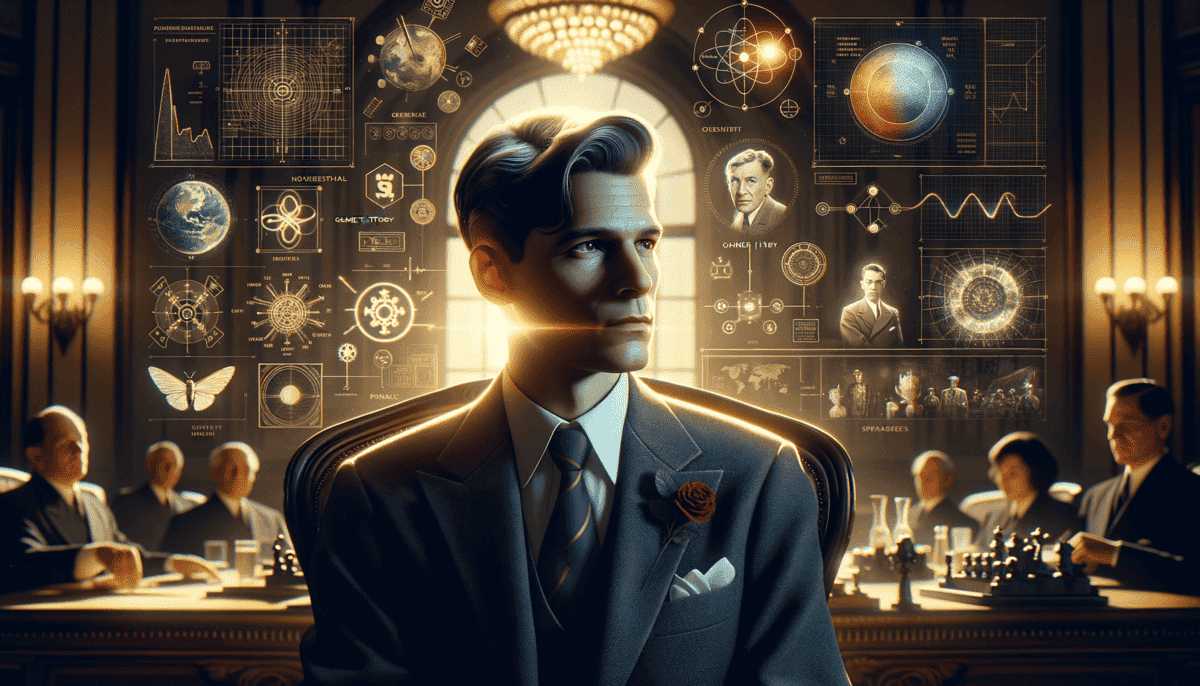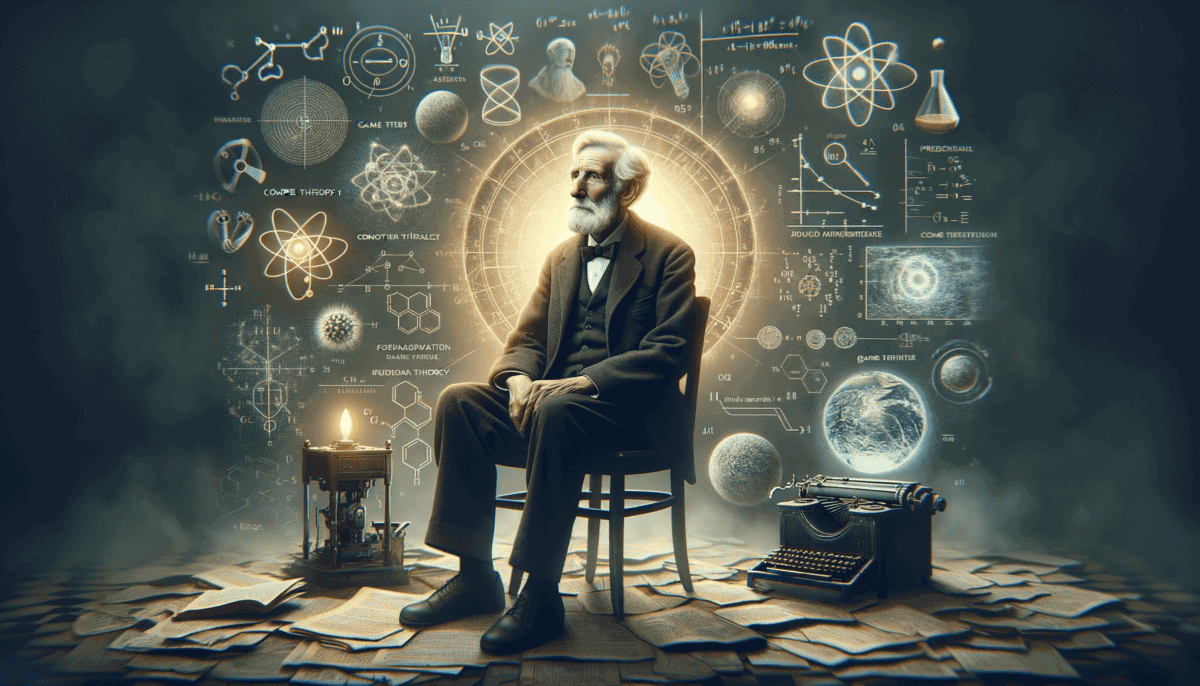The Budapest Prodigy
In a busy city called Budapest, there lived a little boy named Johnny. The year was 1903, and Johnny von Neumann wasn't like other kids. While most children played with toys, Johnny loved numbers!
"Mama, did you know I can divide big numbers in my head?" six-year-old Johnny asked one morning while eating breakfast.
His mother smiled. "Show me, dear."
Without hesitation, Johnny solved math problems that even grown-ups found hard. He could multiply eight-digit numbers in his head faster than anyone could write them down!
Johnny's father was a banker who loved learning. Their house was full of books, and Johnny read them all. He would spend hours in their big library, learning about everything from history to science.
"Papa, why does the ceiling fan spin?" young Johnny would ask.
"Why do boats float?"
"How do birds know where to fly?"
His questions never stopped, and his mind worked faster than anyone had ever seen.
A Special Kind of Smart
Johnny's teachers couldn't believe how smart he was. Once, when his math teacher gave him a hard problem, Johnny solved it in three different ways!
"How did you do that?" his amazed teacher asked.
Johnny just shrugged. "I saw the patterns in my head," he said simply.
Life in Budapest was exciting for little Johnny. The city was full of other smart Jewish families who valued learning. Many children from these families would grow up to be famous scientists too!
Growing Up Different
But being super smart wasn't always easy. While other kids played soccer in the streets, Johnny preferred to think about math problems. He was different, but that was okay.
His sister Klari remembered: "Johnny could do anything with numbers. Once, he even calculated how many seconds old I was on my birthday!"
Young Johnny had special talents:
• Could remember every word from books he read years ago
• Learned new languages in weeks
• Solved complex math problems faster than calculators
• Never forgot anything he learned
• Could think about many difficult things at the same time
The Start of Something Big
Nobody knew it then, but this little boy from Budapest would grow up to change the world. He would help create computers, figure out how to make important decisions, and even help build rockets!
Each night, as Johnny fell asleep in his Budapest home, his mind filled with numbers, patterns, and ideas. He didn't know it yet, but his amazing brain would one day help shape the future of science and technology.
Outside his window, horse-drawn carriages still clip-clopped through the streets of Budapest. Soon, those same streets would see cars, and later, Johnny would help create machines that could think almost like humans do.
But for now, he was just a very special little boy, dreaming big dreams in a city by the Danube River.
His mother often said, "Johnny, your mind is a gift. Use it to make the world better."
Those words would stay with him forever, guiding him through an incredible life of discovery and invention.
Academic Brilliance Unleashed
As Johnny grew older, his amazing brain took him to new places. Now a teenager, he went to college much earlier than most kids. While other teens were still in high school, Johnny was solving problems that confused even college teachers!
The Young Professor
Johnny traveled all around Europe to learn from the best teachers. In Germany, he became the youngest teacher ever at a big university. He was only 23 years old!
"How do you know so much?" other teachers would ask.
"I just see answers in my head," Johnny would say with a smile. "Like watching a movie!"
Making Math Fun
Johnny had a special way of making hard things easy to understand. He could explain big ideas using simple words. Students loved his classes because he made learning fun!
Here are some cool things Johnny did during this time:
• Wrote new math rules that helped build computers later
• Taught at many famous schools
• Helped other scientists solve hard problems
• Made friends with other smart people who changed the world
• Wrote books that scientists still use today
New Adventures in America
In 1930, Johnny moved to America. He got a job at a special place called Princeton University. This school was like a clubhouse for the world's smartest people!
"America needs your big brain," they told him. "We have important problems to solve."
Johnny loved his new home. He even changed his name a little – people started calling him John instead of Johnny. But he was still the same curious person who loved solving puzzles.
Making Big Discoveries
At Princeton, John worked on many exciting projects. He figured out new ways to use numbers that helped build the first computers. He also helped other scientists understand complicated things about atoms and space!
Other scientists would often come to John with their hardest problems. They knew if anyone could solve them, it would be him!
A Special Kind of Teacher
John wasn't just smart – he was also very kind. He helped younger scientists learn and grow. Many of his students went on to do amazing things too!
"Dr. von Neumann taught me how to think differently," one student said. "He showed us that any problem can be solved if you look at it the right way."
Big Ideas, Simple Words
Even though John worked on very complicated things, he could explain them so simply that anyone could understand. He believed that if you really understood something, you should be able to explain it to a child.
"The harder the problem," he would say, "the more important it is to keep thinking simple!"
Looking to the Future
During this time, John started thinking about machines that could think like humans. He imagined computers that could learn and solve problems on their own. Many people thought these ideas were just dreams, but John knew they would come true someday.
As the world changed around him, John kept working, thinking, and solving puzzles. His ideas were like seeds that would grow into amazing new technologies in the future.
Every day, he remembered what his mother told him back in Budapest: use your special mind to make the world better. And that's exactly what he was doing!
Secret Projects and Atomic Science
Dark clouds of war spread across the world. In 1943, John got a secret letter. The United States government needed his help with something very important!
A New Home in the Desert
John moved to a secret city in New Mexico called Los Alamos. It was like a hidden town full of the world’s smartest people. They worked day and night on big problems.
“Why did they pick this desert place?” John asked when he arrived.
“Because no one will look for us here,” his friend Robert Oppenheimer said with a smile.
Super Fast Math
At Los Alamos, John showed just how amazing his brain was. He could do super hard math problems in his head faster than other scientists could with calculators!
Making Friends with Other Geniuses
John worked with lots of famous scientists, including Albert Einstein! They would have long talks about science while taking walks together.
“Your mind works in wonderful ways,” Einstein told John one day. “You see things that others miss.”
Big Questions
Sometimes John would stay up late thinking about their work. He knew they were making something very powerful. He wondered if it was the right thing to do.
Here are some things John thought about:
• How to use science to help people
• What happens when we make powerful new things
• How to be careful with dangerous discoveries
• Ways to protect people from harm
• How to make sure science is used for good
Teaching the Machines
While working on the atomic project, John had another big idea. He realized they needed better ways to do math really fast. This made him start thinking about building smart machines – the first computers!
A Different Kind of War
John knew their work would change the world forever. He helped design special machines that could make very exact calculations. These machines helped the scientists understand things that were too complicated for regular math.
“We must be very careful,” he told his team. “What we learn here will affect everyone on Earth.”
Looking Beyond the War
Even during these serious times, John kept thinking about the future. He dreamed about machines that could think and learn. He imagined computers helping doctors, teachers, and scientists do amazing things.
John wrote lots of letters to his friends about his ideas. “Soon,” he wrote, “machines will help us solve problems we can’t even imagine yet!”
A Heavy Secret
Working on such a big secret wasn’t easy. John couldn’t tell his family what he was doing. He couldn’t even write about his work in his diary!
But he knew this work was important. It would change how people thought about science forever. It would also make people think harder about how to use powerful new discoveries.
As the war came closer to ending, John and his friends kept working. They knew their discoveries would open up a whole new chapter in human history.
Building the Electronic Brain
The year was 1945. The big war was over, but John von Neumann wasn’t done thinking big thoughts! He had a new dream – to build a machine that could think like a human brain.
A Special Machine
John drew pictures of his idea for a new kind of computer. It wasn’t like the counting machines people had before. This computer could remember things and follow lots of different instructions!
“What if we could make a machine that thinks?” John asked his friend Herman Goldstine one day.
“People might say that’s impossible,” Herman replied.
John smiled and said, “Let’s show them it’s not!”
Building the First Computer
At Princeton University, John and his friends started building a special computer. They called it EDVAC. It was as big as a room!
The computer had special parts:
• A memory to remember things
• A brain to do math
• A way to take in information
• A way to show answers
• A control center to run everything
Teaching the Machine
John spent lots of time thinking about how to talk to computers. He figured out that they could understand instructions written in numbers – just like a recipe for baking cookies!
Making Friends with Machines
Scientists from all over came to see John’s computer. They were amazed! The machine could solve hard math problems in seconds that would take people hours to figure out. ⚡
John’s daughter Marina remembered watching her dad work: “He would talk to the computer like it was his friend. He knew it could do amazing things!”
Looking to the Future
John had big dreams about what computers could do someday. He said they would help:
✨ Doctors find new medicines
✨ Scientists understand the weather
✨ People learn new things
✨ Make cars and planes safer
✨ Help us explore space
Sharing the Knowledge
John wrote a special book about how computers should work. He shared his ideas with everyone. He wanted other people to build even better computers!
Problems to Solve
Sometimes the big computer would break down. Parts would get too hot, or wires would stop working. But John and his team never gave up! They kept making it better.
“Every problem is just a puzzle waiting to be solved,” John would say.
A New World of Ideas
John’s computer ideas changed everything! Soon, other scientists started building their own computers. Each one was better than the last.
John was so happy to see his dream coming true. He knew computers would help people do amazing things. He imagined a future where everyone would have their own computer to help them work and learn.
Every time you use a phone or computer today, you’re using ideas that John thought of first! His electronic brain changed our world forever.
Playing the Game of Life
As the world worried about big bombs and scary wars in the 1950s, John von Neumann had a new idea. He wanted to understand how people make choices when things get tricky.
A New Kind of Math
One morning, John woke up excited. “I know how to study why people do what they do!” he told his wife Klári at breakfast.
“How?” she asked, stirring her coffee.
“We can turn it into a game!” John’s eyes sparkled. “Everything people do is like playing a game with rules and choices!”
Teaching Leaders to Think Better
Important people in Washington D.C. heard about John’s ideas. They asked him to help them make smart choices about keeping America safe.
“What would happen if…?” became John’s favorite question. He helped leaders think about different ways things could turn out.
Playing with Numbers
John showed how to use numbers to understand tricky choices:
• When to work together
• When to compete
• How to share things fairly
• What to do when others don’t play nice
• How to make everyone happy
Helping Make Peace
During the Cold War, John’s ideas helped leaders make better choices. He showed them that working together could be better than fighting. ️
“We can use math to find ways to get along,” he explained to worried politicians.
Teaching Others to Think Ahead
John spent lots of time teaching young scientists. He wanted them to use his ideas to solve big problems.
Big Ideas for Everyone
John’s game theory wasn’t just for big world problems. It helped people understand:
How to play better chess
How to run better businesses
How to make better deals
How to protect nature
❤️ How to be better friends
Looking at the Future
As John got older, he worried about how powerful science was becoming. He wanted people to use his ideas wisely.
“With great knowledge comes great responsibility,” he would tell his students.
Making Things Better
Even when he was sick, John kept thinking about how to help people work together better. He believed his game theory could help solve problems all over the world.
Marina, his daughter, remembered: “Dad always said that understanding each other was the most important game of all.”
Ideas That Live On
Today, people still use John’s game theory ideas. They help with:
✨ Making fair rules
✨ Sharing things better
✨ Solving arguments
✨ Building trust
✨ Working together
John’s special way of thinking about choices and games changed how we solve problems forever. His ideas help us make the world a little bit better every day.
A Mind That Saw Tomorrow
In 1957, John von Neumann lay in his hospital bed, but his brilliant mind was still racing ahead into the future. Even though he was very sick, he kept sharing amazing ideas about what was coming next.
Last Days, Lasting Dreams
“Tell me more about the thinking machines, Dad,” Marina asked, sitting beside his bed.
John’s eyes lit up. “One day, computers will be everywhere. They’ll be tiny but super smart. They’ll help people do amazing things!”
Seeing the Future
John told people about things that seemed like magic back then, but are real now:
• Tiny computers in everyone’s pocket
• Machines that can learn and think
• Robots doing jobs
• Computers talking to each other
• Technology changing how we live
Worried About Tomorrow
Even though John was excited about the future, he worried too. “We must be careful with these powerful tools,” he told his friends. “They can help us or hurt us.”
A Special Gift
Before he died, John gave his daughter Marina a special notebook. “These are my dreams for tomorrow,” he said. “Share them with people who want to make the world better.”
Ideas That Changed Everything
John’s ideas helped create many things we use today:
Modern computers
Artificial intelligence
Better ways to solve problems
The internet
Smart devices
The Story Lives On
When John died in 1957, he left behind more than just his discoveries. He left us a way of thinking about the future that helps us:
✨ Dream big dreams
✨ Solve hard problems
✨ Work together better
✨ Use science wisely
✨ Make tomorrow better
A Forever Light
Today, scientists still read John’s ideas and say “Wow!” His smart thinking helps them solve new problems and make cool discoveries.
Einstein once said, “Johnny was the smartest person I ever met.” But John was more than just smart – he was someone who used his smarts to help everyone.
The Future He Saw
Many things John dreamed about are here now. But some of his biggest dreams are still coming true. Every time someone uses a computer or solves a big problem using his ideas, John’s light shines a little brighter.
The little boy who loved numbers grew up to change the world. His story teaches us that with big dreams and hard work, we can all help make tomorrow amazing! ⭐


